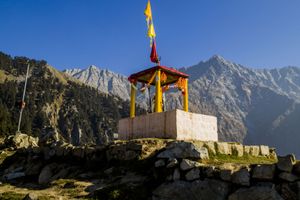In the foothills of the great Himalayan Mountains, the Kalatop Wildlife Sanctuary remains a preserved area for native flora and fauna. Stretching for nearly 20 square miles, this reserve is home to many large mammals, including leopards, and dense forest. As you plan your trip to Northern India, include the Kalatop Wildlife Sanctuary in your itinerary as a pleasant day out in nature.
Absorbing the History
This sanctuary isn't like a traditional zoo. Indeed, there are no fenced-in grounds or exhibits. It remains an open area for native flora and fauna to wander and diversify. During British Rule, the Chamba rulers used it for hunting grounds. After Indian Independence, locals fought to preserve the area in the 1960s. However, it wasn't until the 1970s when the sanctuary was officially protected and opened for curious visitors. Today, it's a rich environment of birds, land animals and native plants.
Becoming One With Nature
A popular activity within the sanctuary is trekking through the trees. Here, you'll find Himalayan cedar, Blue pine and various oak trees. Because these forests are extremely old, the undergrowth is considerable. Rich soil gives rise to ferns, rhododendrons, mosses and more flora.
As you trek within the Kalatop Wildlife Sanctuary, bring a picnic. Because trekking can take a few hours to see the sanctuary's highlights, stopping for a snack is highly encouraged. Simply pack your trash to protect the reserve.
Taking a Safari
If trekking by foot isn't possible, there are car safari options. Typically, check in with the District Forest Officer for vehicle access. There's a nominal fee, which contributes to the sanctuary's care and upkeep. Then, you can drive across the protected zone to see the region's highlights. For optimal sightseeing, take a safari drive on a sunny day. Wet or snowy conditions can hinder your movements or driving won't be allowed outright, depending on the weather.
Watching the Wildlife
If you're a bird-watching enthusiast, the sanctuary is a perfect place to hone your skills. For example, look for the Western tragopan, Himalayan monal, Eurasian jay and the grey-headed canary. From large to small species, birds use the dense forest for nesting year-round.
Naturally, larger animals are a highlight on your trip to the Kalatop Wildlife Sanctuary. Enjoy Rhesus monkeys, barking deer and flying squirrels in the region. Trekking and observing the animals can give you a glimpse at the diverse environment in the Himalayan foothills.
Adventurous Activities
To attract more visitors annually, the sanctuary also offers an adventure park. Here, children can climb and safely play in designated areas. For adults, consider the paragliding options nearby. On a warm and windy day, visitors are welcome to pay a small fee to glide down the hillside on a colorful paraglider. Because this attraction is weather-dependent, verify its availability before heading to the paragliding area.
Planning Your Itinerary
Because the sanctuary is a protected area, most visitors stay in and travel from Dalhousie. Located about 5 miles away, Dalhousie is a small town with breathtaking views. Book your hotel here, and hire a taxi to take you to the sanctuary. Typically, the sanctuary is open from 7 a.m. to 6 p.m. daily. For the best weather, visit in the spring or fall. Between June and August, monsoonal storms make trekking difficult along the foothills.
With a maximum elevation of nearly 10,000 feet, explore the Kalatop Wildlife Sanctuary leisurely. Luckily, there are many stops along the pathways and plenty of shade during those sunny days. By taking your time at this elevation, you can listen to the Ravi River, and the surrounding wildlife while taking in the breathtaking views of the nearby mountain ranges.



















